ProWritingAid vs. Grammarly – find out which one is the best writing and editing software on the market. See the detailed review, screenshots, and video demos so you’ll know exactly which one to use and why. You may be surprised by the results!
In this “grammar checker” software review, you’ll see the differences between them, including demos that compare their proofreading performance on identical pieces of text.
Who can benefit from grammar editing software?
Pretty much anyone who wants their work to look polished and professional will benefit from using proofreading and editing software. Here are examples of ways to use it:
- check for typos in articles for your freelancing clients
- FREE proofreading software for your blog posts!
- book editing software (including novels, non-fiction, short stories, etc.)
- paper and essay editing software
- professional grammar check for your email
Anyone learning to write in English as a second language can also benefit from this type of English editing software.
And the good news is that even if your budget for this is a big ‘ol ZERO, these are two of the best FREE options available.
Let’s start with what these services claim to do, along with pitfalls to avoid when using them.
ProWritingAid vs. Grammarly: Which one is the best proofreading software?
When I was searching for the best grammar checker app, I was intrigued by Grammarly’s claim (on their home page) saying their app “makes sure everything you write is clear, effective, and mistake–free.”
The truth is that this is a bit of an exaggeration and can lead to writers putting too much trust in their grammar correction software. It would have been more accurate for them to say something like “closer to mistake–free“. Because while you can indeed produce better writing with Grammarly, it most certainly does NOT completely eliminate typos, as you’ll see in the video demo and screenshots coming up.
It’s important for you to check those out because knowing its strengths and limitations means you’ll be able to use this type of “automatic editor” more effectively.
Personally, I’ve tried both the free and paid Grammarly Pro editor. In my case, the paid version of this particular writing and editing software flagged too many NON-mistakes for my liking. Your mileage may vary.
That being said, I highly recommend their no-cost option (** provided you know what types of errors it’s good at catching and where it goes wrong – keep reading to find out more).
But, don’t stop there. You need to supplement it with a second free, online grammar checker – ProWritingAid – for best results. (A paid, premium version is also available with added features… I’ll show you what they are later in this review.)
And so you don’t have doubts, in the video and screenshots below I’m going to show you exactly why I recommend them so highly.
I put both of these writing/editing apps to the test with some sample sentences to show how they compared. Watch this video to see it:
If you watched the entire video, you can either review the results in more detail below or skip ahead to the section titled “Performance summary”.
And if you don’t have time to watch the video, then read through the results of the test here:
Grammarly vs. ProWritingAid: Which one is the best grammar checker software for catching verb problems?
It’s important to know if this type of free writing/editing software is capable of catching simple verb problems (for example, using the word “run” instead of “runs”, or writing “is” instead of “am”).
If you’re a native English speaker, you may think the errors below are far too basic to be something that would show up in your own work.
But the main risk comes from your editing if you decide to reword things using a different pronoun (I, you, he, she, it, etc.).
For example, perhaps you wrote “When I do ….” then you decided to change it to “When one does …”. If you’re in a hurry or tired when making this alteration, you could easily forget to change “do” to “does”.
ProWritingAid offered the correct solutions for three errors, but missed the final two mistakes.
Score: 3/5
Grammarly did fantastic here, correctly offering solutions for all five errors.
Score: 5/5
WINNER: Grammarly
Before you quit reading because you think you’re clearly safe to use Grammarly exclusively, check out which editing software won the next round…
The best proofreading software for catching soundalike word mistakes
This is another type of goofy mistake that all of us make occasionally. Sure, we KNOW how to use these words correctly, but our traitorous brain doesn’t always call our attention to it when we do it wrong. Luckily, these online editing tools for writers have come to the rescue!
As you can see in the above image, ProWritingAid was the best free grammar checker this time, as it only missed one mistake where “vane” was used instead of “vain”.
Score: 5/6
This time Grammarly falters a bit. It correctly found the typos in four out of six sample sentences, but messed up for two of them:
- in the second sentence, it missed the fact that “some” should be “sum”, and mistakenly flagged “is” as an error
- in the third sentence, it didn’t notice that “four” should be “for”
Score: 4/6
WINNER: ProWritingAid
The good news is that if you’d used both of these editing programs, you‘d have caught 100% of the errors made. And anyone who is fluent in English would easily recognize the fact that “is” was a false alarm.
The best free grammar checker for catching “it’s” vs. “its” typos
Everyone – even the most highly skilled writer who knows better – messes this up from time to time, so let’s see if these online proofreaders can save us!
As you may recall, “it’s” can only be used if it’s standing in for “it is”. For this test, the only error that ProWritingAid missed is in the final sentence where “it’s” should have been written as “its”.
Score: 4/5
Let’s see how the competition does:
Two errors were missed this time (PWA only missed one).
Score: 3/5
WINNER: ProWritingAid
But once again it’s worth noting that if BOTH programs had been used, every single one of these typos would have been flagged.
ProWritingAid vs. Grammarly: Which is the best grammar checker app for flagging mistakes with then/than and there/their?
These are another common source of typos that tired eyes can easily miss. Let’s see if either online writing editor can catch these.
ProWritingAid aced “then” versus “than”.
And it also did pretty good for “there” versus “their”. In sentence three (“There car was expensive”), it incorrectly flagged the word “car” as an error because it thinks it should be “a car” or “the car“. However, if you change “there” to “their“, PWA no longer flags the word “car” as an error. The exact same issue occurred with “… in there situation”. And in the final sentence, it missed the error altogether.
Score: 6/7
As you can see, this program also had no problems at all with “then” versus “than”.
But in the second set of problem sentences, it missed the mistake in the fourth one.
Score: 6/7
These are two of the best writing and editing tools out there. But, please note that if you’d only used one of them you‘d have missed a mistake. By using both, you‘d catch 100% of the errors because the single mistake missed by each program was different.
WINNER: It’s a draw.
The best grammar checker online (free) for catching missing apostrophes
These itty bitty punctuation marks are all-to-easy for tired eyes to forget when they’re incorrectly absent from a word. How good are these programs at detecting that kind of error?
Both programs caught 100% of the missing apostrophe errors.
Scores: 3/3 for both.
WINNER: It’s a draw.
However, it’s worth noting that unlike ProWritingAid, Grammarly also noticed the fact that the extra word (“is”) snuck in there. It correctly recommended that “is” be removed from the sentence.
The best free editing software for flagging double words
I don’t know about you, but I know for a fact that I make the mistake of the dreaded double word from time to time. And it almost always happens with tiny two– or three-letter words that are easy for my eyes to miss. For that reason, I’m a huge fan of any automated grammar check software that can flag this type of mistake. And I bet you will be, too!
The above result bummed me out. No matter which one of their screening tools I used, it couldn’t catch the double words.
Interestingly, when I pasted the text of this blog post into its free online text editor prior to publication, it caught me when I wrote “and and” by mistake. So I’m not sure why it noticed that, but not the ones in the screenshot above.
Score: 0/4
Looking at Grammarly vs. ProWritingAid for this type of error, the winner is clear. The former caught every single incidence of double word usage.
Score: 4/4
WINNER: Grammarly
Also worth noting is that neither program noticed that in the third sentence “to to” was intended to be “to do”. I even tried eliminating the extra “to” in sentence three, to see if that might result in the missing word “do” being noticed, but it didn’t work.
The best grammar editing software for catching “to” vs. “too” errors
Whether you’re a writer who is confused about how to use these words, or you know exactly how to use them correctly but are prone to typos as all of us mere mortals are, both of these programs can help.
While the grammar editing app caught the first mistake, it missed the second one.
Score: 1/2
Both errors were caught, for a perfect score!
Score: 2/2
WINNER: Grammarly
Performance summary

This test was designed for testing 32 specific kinds of typos that writers of all skill levels tend to make.
ProWritingAid caught 22 of them.
Grammarly caught 27 of them.
But if both were used, 100% of the mistakes were flagged.
The goal of any ProWritingAid review or Grammarly review is to figure out which one is the best proofreading software. But in this case, the ideal results come from using both.
Other differences
The free version of ProWritingAid checks for a bunch of useful things that Grammarly does not. ProWritingAid will check for words that you use too often (one of my favorite features!), overall readability, overuse of pronouns, and acronyms that may require definition.
Both allow you to change which version of English you use, including U.S., UK, Canadian, and Australian English. I find this a particularly handy feature when I’m freelancing and guest blogging since it allows me to easily adjust my spelling depending on which country my content is primarily intended for. And of course, if you’re an author or student you can select the form that’s used where your work will be read.
There’s a key difference in how each online editing software handles language selection though. Grammarly makes you go into your account settings to change it. ProWritingAid allows you to change it quickly and easily within the actual editor, which is great since it means you don’t have to click away from your work. Check out the screenshot below to see what I mean:

One of the keys to making your writing flow and be interesting is to vary your sentence length. ProWritingAid analyzes this for you, and will let you know if you should consider adjustments.
Also, ProWritingAid preserves your formatting when you copy content into their online editor. Grammarly does not.
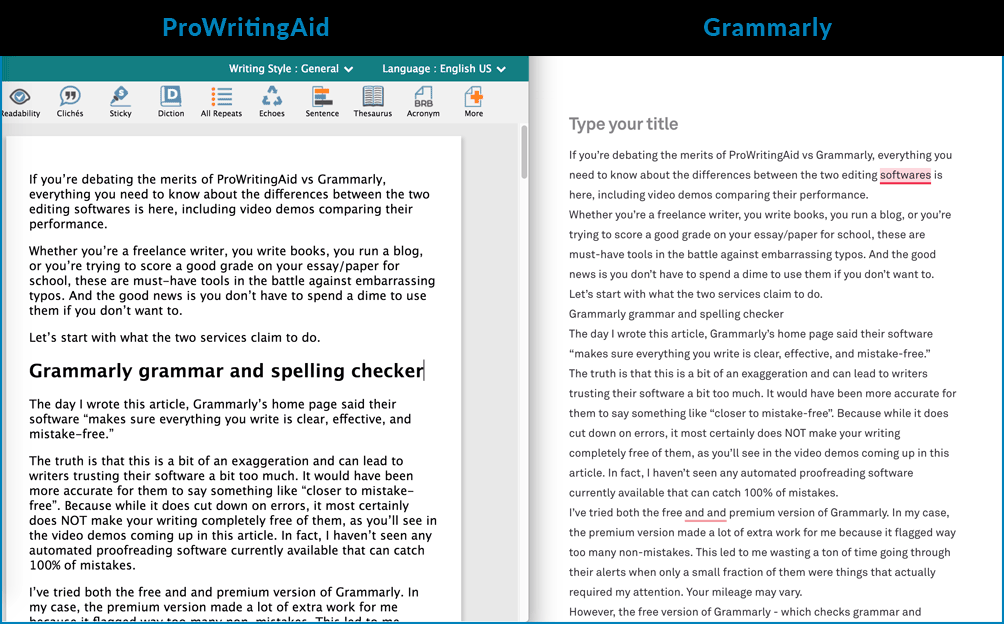
Grammarly vs. ProWritingAid integrations and other cool features
Grammarly has a free browser add-on for Chrome, Firefox, Safari, and Edge browsers. They also have an integration with Microsoft Office on Windows (but not Mac).
ProWritingAid Premium licenses allow you to use their browser add-on for Chrome which works with the ever-popular Gmail, Facebook, and even WordPress.
ProWritingAid Premium also has a direct integration with Google Docs, Scrivener, and Microsoft Word on Windows. There is also a desktop version available for Windows and Mac. (Mac users have to use the desktop app for working with Word docs).
Both of these have a built-in thesaurus, which means you don’t need to keep a separate browser window open for this purpose. Double-click on any word in their online editors to pull up a list of synonyms for your consideration.
Both programs provide varying degrees of plagiarism checks with their premium versions.
Here’s an infographic to sum up the key differences between them:
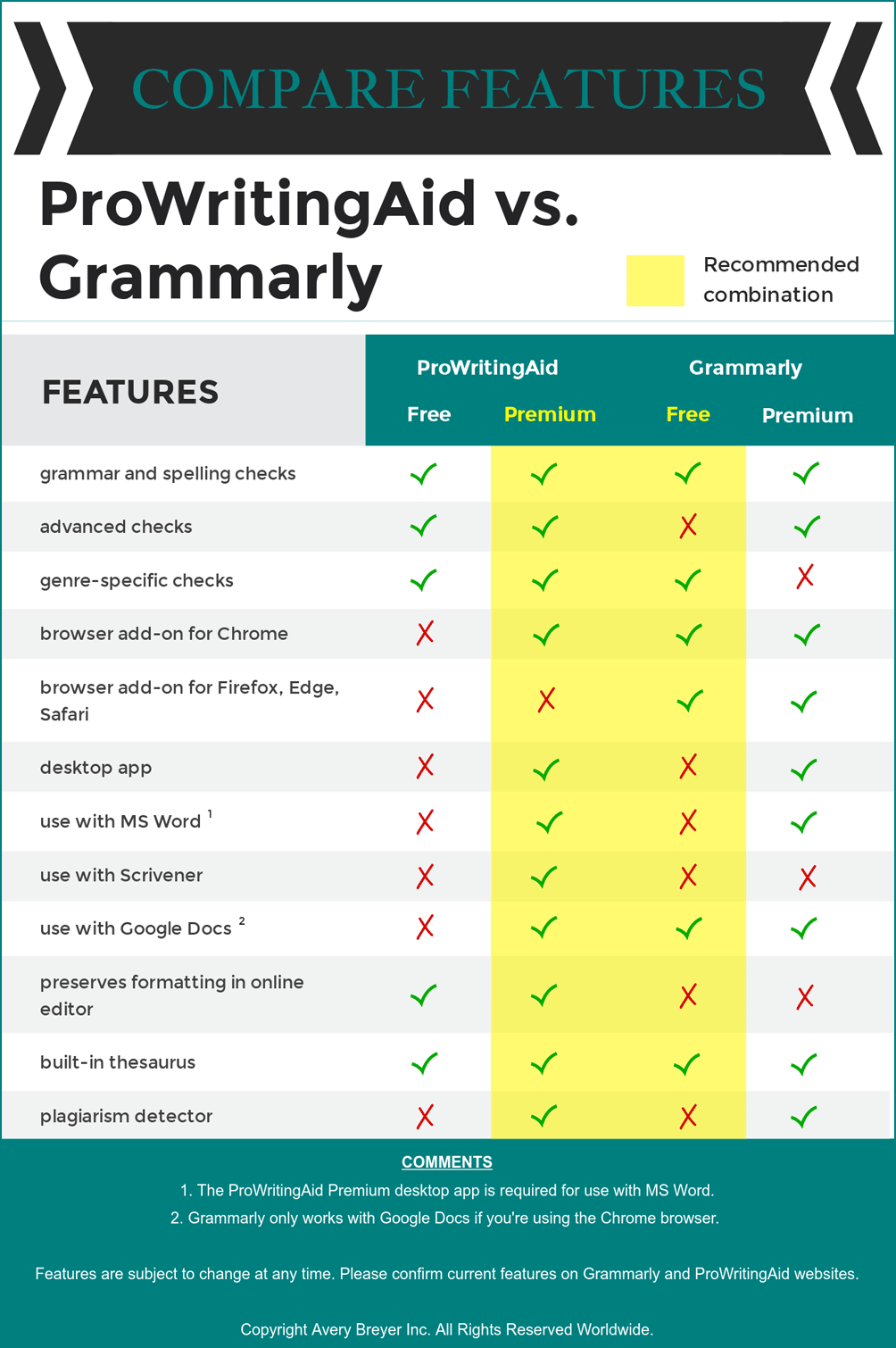
ProWritingAid vs. Grammarly pricing
Both can be used as paid or free proofreading software. I tried the premium version of Grammarly in the past, wasn’t happy with it, so I cancelled.
Why wasn’t I happy with the Premium version of Grammarly? The majority of premium errors it flagged in my work were not actually errors at all. So I wasted a lot of time going through them. Your mileage may vary though. In any case, I think the free version is best for most people.
However, if you want to try Grammarly Pro for yourself – who knows, it may have improved since I tried it – you certainly can. At the time of this writing the following pricing options are available:
- pay 29.95 USD each month
- pay 59.95 USD every 3 months (averages out to 19.98 per month)
- pay 139.95 USD once a year (averages out to 11.66 per month)

Full disclosure – and you probably won’t be surprised after reading this ProWritingAid review – because I frigging love it so much, I bought lifetime access to ProWritingAid Premium version a while back, with zero regrets. Their typo-obliterating grammar software is an indispensable tool in my writer’s toolbox. The thing is, I wonder if – as they become more popular – they’ll eventually move to a subscription-only pricing model. So I wanted to make sure I got in with the one-time fee while it’s still an option.
That being said, worst case if the ProWritingAid Lifetime plan doesn’t fit your budget, you have options.
First, you can use their free version if you like. I don’t know if they’ll provide a free version forever, but it’s definitely something you can use for now.
Alternatively, if you want everything they have to offer including their integrations and desktop app, here’s a screenshot of ALL of their pricing plans (updated Jan 11, 2022):

There’s no question that ProWritingAid’s premium plan is much less expensive than Grammarly’s when you compare the yearly cost of one versus the other. And better still, if you sign up for the ProWritingAid Lifetime plan, you’ll only pay once.
Please check their website for current pricing options.
or…
Sign up for the free version of ProWritingAid here.
What’s the best proofreading software for you?
It’s a no-brainer to use both of these – even if you only use the free versions – since the combo did a better job of eliminating typos than either one alone. Remember, there were several examples above where each program caught different errors – so if you’d only used one, you’d have been worse off.
But… please take note of the following recommendation:
My ideal combination is to use the FREE version of Grammarly and the paid version of ProWritingAid Premium.
In my opinion this is not only the most effective option, it also provides the most bang for your buck.
ProWritingAid Premium licenses provide the following extra advantages that you don’t get with the free version:
- you can edit directly in your browser without needing to copy and paste into their online editor
- fantastic integrations with popular word processing programs like MS Word, Google docs, and Scrivener
- you get the desktop app for even more flexibility
- awesome long-term savings with their lifetime plan – it’ll pay for itself when you consider the amount you’d spend on their subscription plans
Important information you need to know: Both Grammarly and ProWritingAid offer referral commissions to anyone who refers someone to their paid versions. Why is this important? You need to consider if I – or someone like me – is recommending this to you because I want to make money off referring you or if it’s because I honestly believe this combo is best.
I will never recommend something to you unless I truly believe in it. But talk is cheap, and the internet is full of liars who will say anything to make a buck so…
My goal with the video demo and screenshots above is to take away any subjectivity and allow you to make an objective decision based on the reality of how these services actually perform in real life, rather than leaving you to the mercy of opinions on the internet, hype and popularity contests.
The verdict
You can start by trying the free grammar check functionality with each of these – you don’t have to commit to anything, so you have nothing to lose.
However, I think ProWritingAid is one of the most useful writing/editing tools available, so is well worth the cost of buying access to their lifetime plan. This way you can avoid monthly subscription fees, have access to their full feature set, and know you’ll never have to pay again.
But, because Grammarly can provide you with an additional grammar check online, free, no download required… it’s a no-brainer to use that as your backup. As you can see from the tests I ran above, the combination of these two services is far superior to using either one alone. So use them both for a wickedly good automated editing system for all of your writing.
Action steps:
>> Sign up for ProWritingAid FREE or PREMIUM here.
>> Sign up for Grammarly here.
>> Now test them out. I’m confident you’ll love them!
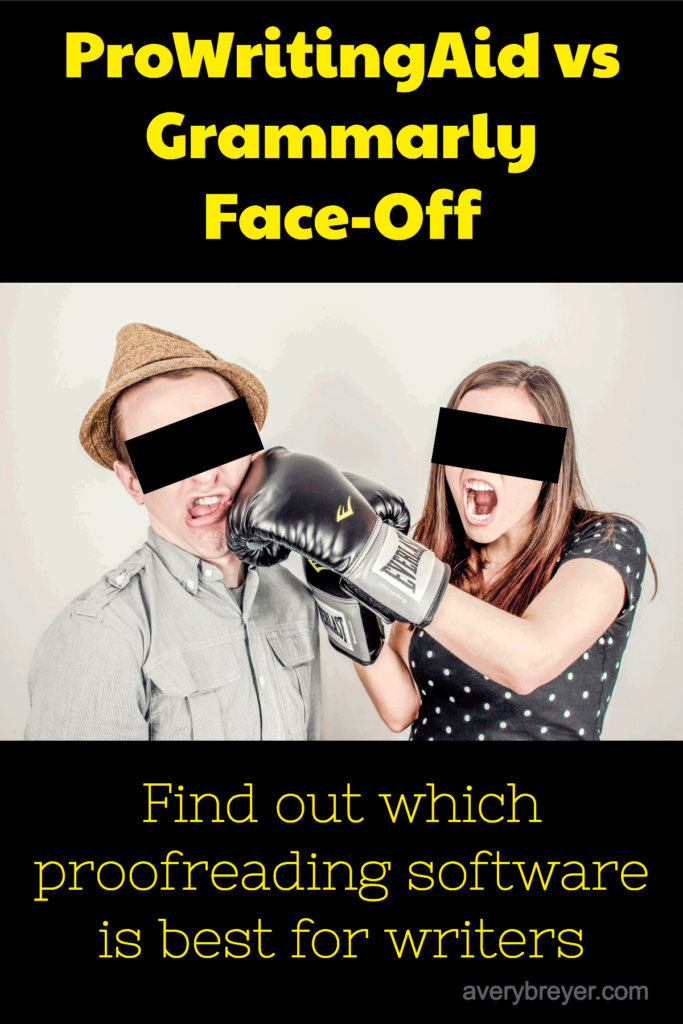

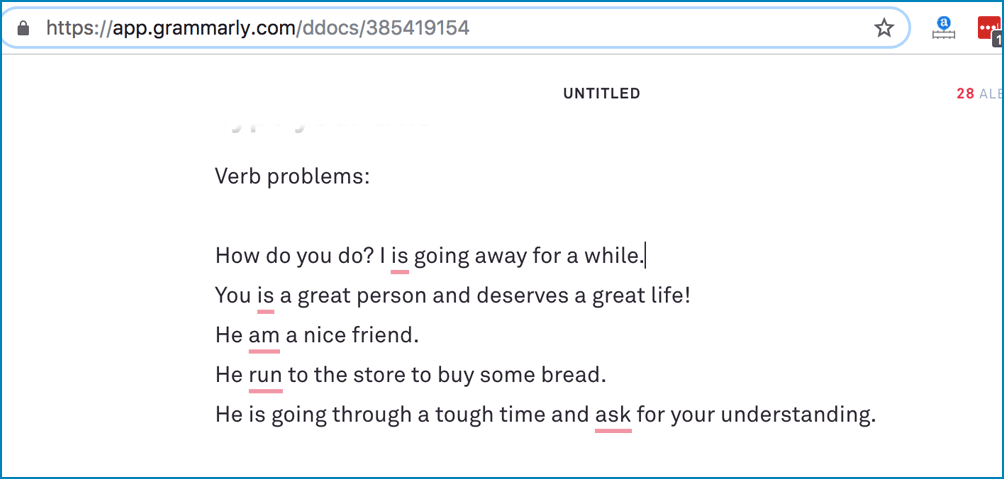
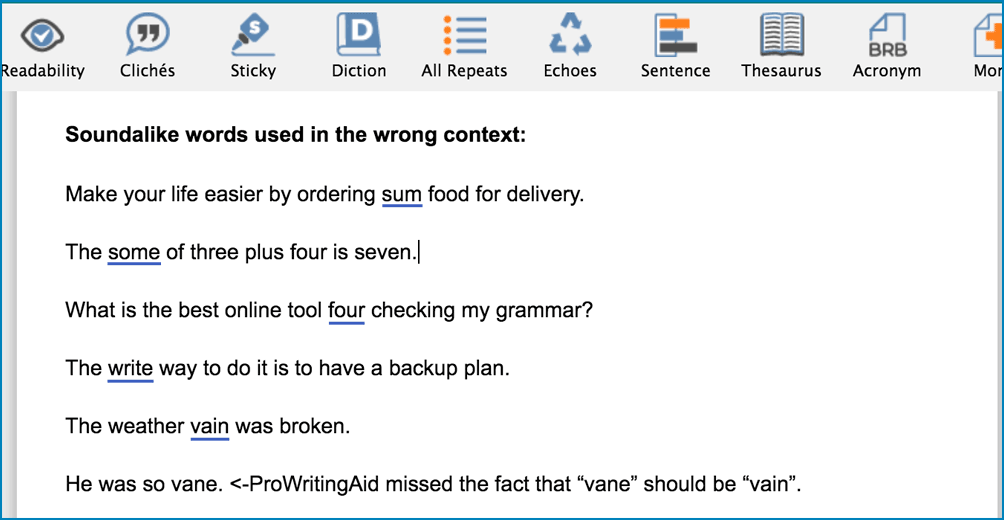



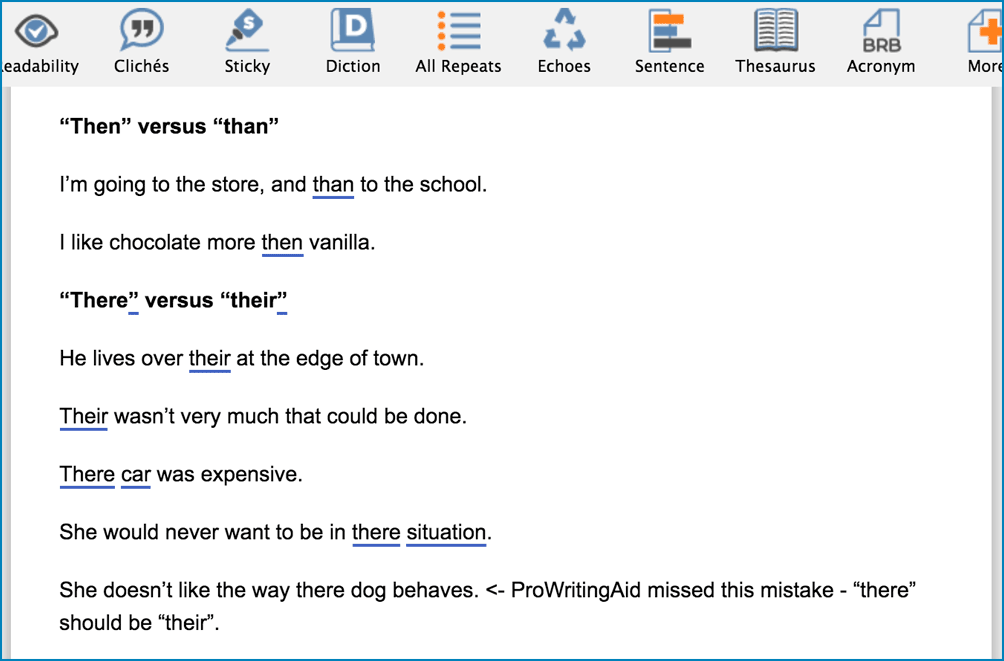
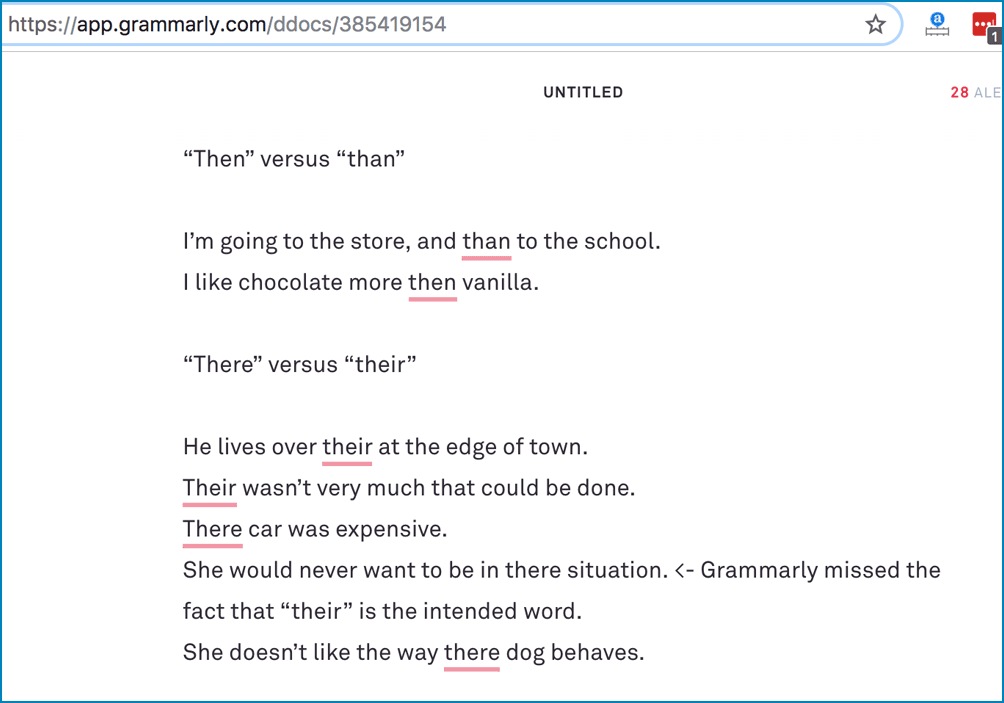
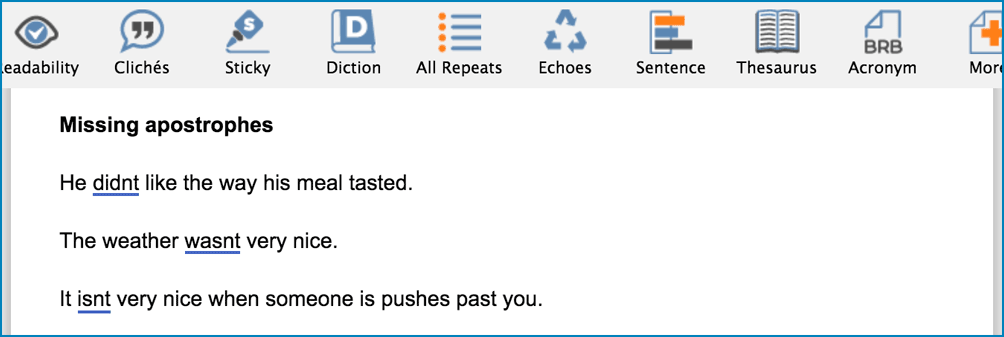

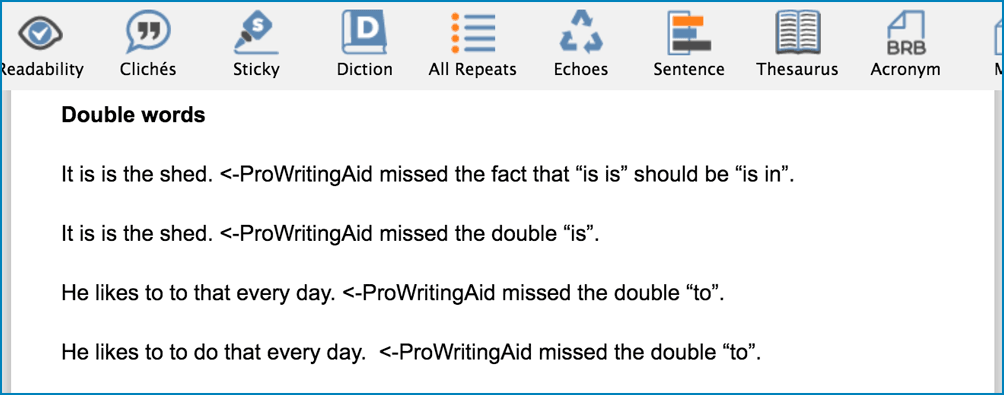
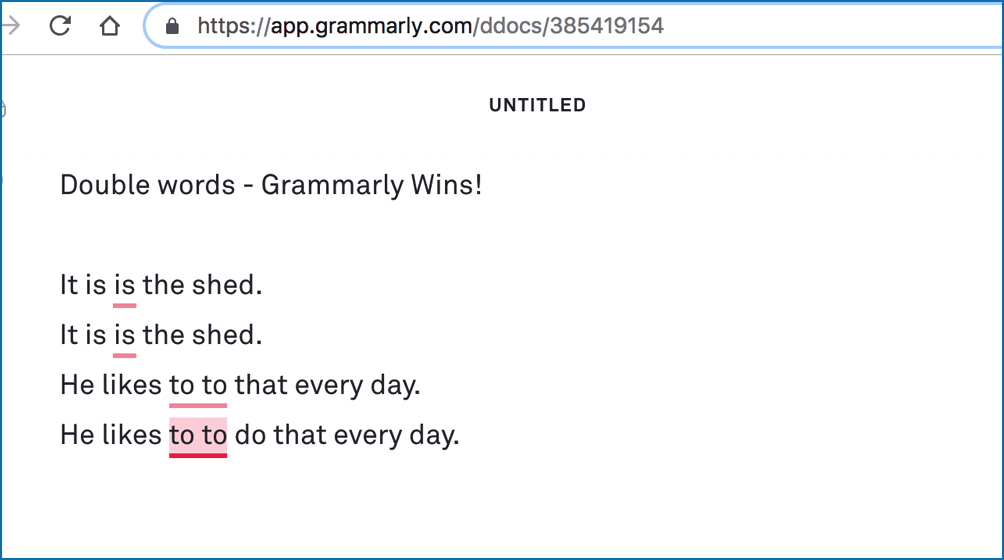
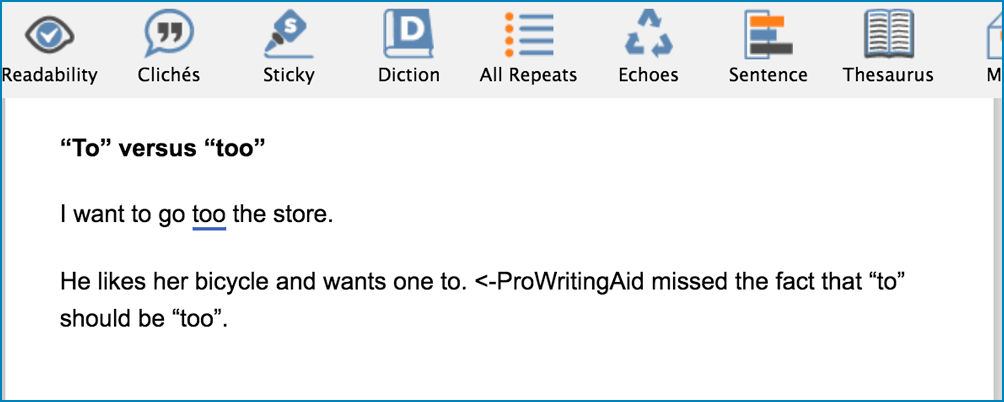
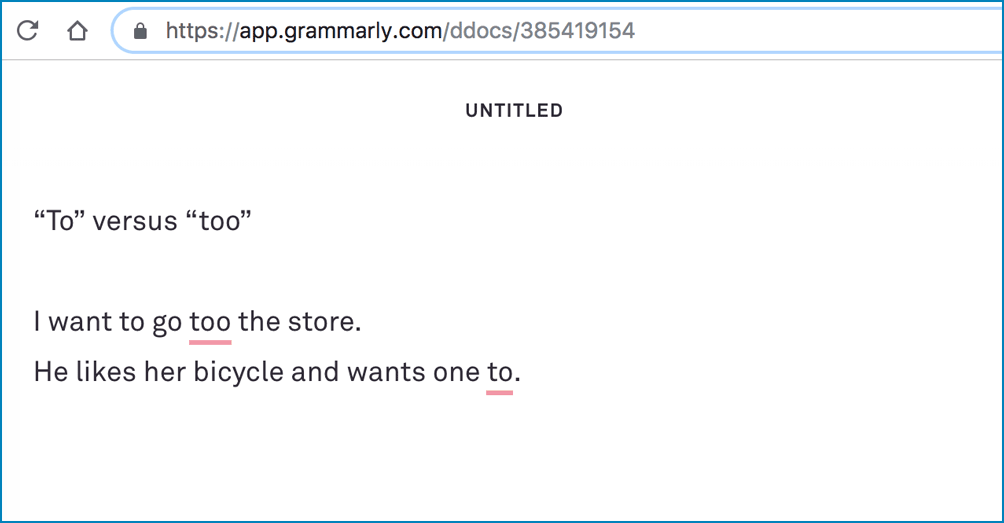
I’m a professional proofreader, and there is a reason people hire me and actually pay me by the hour. I use Grammerly on my Facebook page, because it’s like toy proofreading compared to a professional proofreader.
I think hiring a professional is overkill for most people’s writing needs. (And I say this even though I fully acknowledge that no automated tool on the market today is as good as an experienced human proofreader.)
ex. Resume writing, freelance SEO writing jogs, blog posts, emails, letters, comments on blog posts, comments on social media, etc. are the types of things that for most people would not warrant the hiring of a human proofreader – and in such cases, these automated tools are great for finding errors, even if not perfect…
And for all writing, the more errors these tools eliminate, the fewer errors will be left for the human proofreader to find (whether that’s the original writer or a hired proofreader).
I hire a progressional proofreader for my books. (However, I still plan to run my future manuscripts through these softwares BEFORE sending it to my proofreader since my human proofreaders always miss some errors that these tools can pick up on. I’m not knocking them – they do a good job and I’m glad to have them… but no human can be perfect 100% of the time, hence my desire to further cut down on typos by adding these tools to my book manuscript workflow.)
For my freelance work, the only things I use are ProWritingAid (Lifetime), Grammarly (free), and my own eyes for the final pass. There’s simply no time for me include a professional proofreader in my freelance workflow… not to mention the fact that I’d have to increase my freelance rates if I did so. 🙂
ProWritingAid is much, much better than Grammarly. At least in 2018 it was. I tried both premium versions.
Specially if you are not a Native English speaker. Grammarly could not get most of my grammar mistakes and spell mistakes… It also did not suggest Better ways to write what I was writing, which for a non-native is essential.
Finally, ProWritingAid offers a LifeTime option! Grammarly does not. Instead of paying lots of money per year for something that annoyed me so much, I picked the best one, ProWritingAid, which can perform MANY (so many that I get lost on what it can do) types of analysis in small and long texts.
I mostly use their browser plug-in, google drive extension and their online editor.
ProWritingAid also upgraded a lot during the last year, and I am happy that I paid the LifeTime. The new functionalities and integrations are really nice.
Thank-you so much for taking the time to share your experience with these. 🙂
Hi! I’m so glad I found this post. I recently found ProWritingAid and I like it SO much better than Grammarly. I’m a freelance writer, and really want the premium version, but I’ve been having issues with ProWritingAid working on Google Docs. When I run the Add-on and then tell the app to update my document, it just messes everything up. Nothing is formatted correctly, there are run-on senteces, words grouped together… it’s a mess. The agency I write for has very strict formatting rules, and I’ve saved the formats to my Docs settings, so typing into the ProWritingAid editor and then pasting doesn’t work for me, because then I have to reformat it again, which is a massive pain. Any suggestions or fixes for the Google Docs Add-on?
Hey there! I haven’t run into the specific issue you describe, so I recommend that you reach out to the ProWritingAid support team for help. They’ll be in the best position to help you figure out what’s going on.